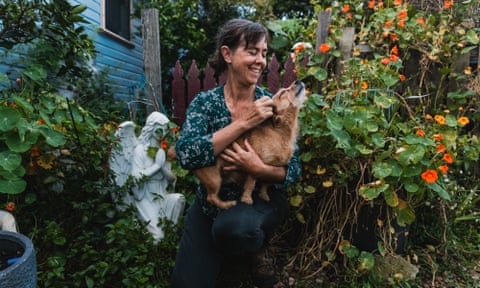‘I’m never going back to living like this’: how an innovative project is helping hoarders
‘I’m never going back to living like this’: how an innovative project is helping hoarders
Share:
Gloucester council approach offers psychological support, decluttering advice and cuts through shame of poorly understood condition. Carol has been trying to clear her home for two years but in her maelstrom of dishevelled possessions, there is still nowhere to sit – and barely anywhere to stand. To her, however, things look great. She is delighted that the chaotic towers of tumbled clothes, yellowed newspapers, pebbles and innumerable bags stuffed into other dusty bags are now waist- instead of shoulder-high: six months ago, these perilous mountains teetered close to the stained ceilings, brushing the thick cobwebs that still hang from broken light fittings.
![[Amelia Hill]](https://i.guim.co.uk/img/uploads/2017/10/06/Amelia_Hill,_L.png?width=75&dpr=1&s=none&crop=none)
Carol has no illusions about what is going on. “I’m surrounded by my trauma,” she says, her thin face peering out from behind a barrier of hair and hat. “All this stuff is the physical manifestation of the actual traumas I’ve suffered and not dealt with. “I couldn’t clear this stuff out before, because everything I touched re-triggered a trauma. It made any attempt to clear too exhausting, mentally and physically, to actually achieve,” she adds.
![[A white bathroom that has been neglected, with discarded items covering the floor]](https://i.guim.co.uk/img/media/be1f8947c10c2455aaee624dbfdd6b6dd13da44e/0_899_5504_6880/master/5504.jpg?width=445&dpr=1&s=none&crop=none)
Only recognised as a standalone mental health disorder in 2013 – but still strikingly under-researched – hoarding is thought to affect between 2.5% and 6% of the population. According to the recent US Senate report, The Consequences of Clutter, an ageing society means this number is likely to increase. “If it rises at this rate and continues to rise, we’re going to be facing a hoarding pandemic,” said Dr Lynne Drummond, author of the recently published Everything You Need to Know About Hoarding.
![[bedroom filled stuff]](https://i.guim.co.uk/img/media/c332c282b4ff9a961555264733c2e4ee9dadb3c1/0_358_8256_4954/master/8256.jpg?width=445&dpr=1&s=none&crop=none)
Hoarding, too often, is an issue of life and death. In 2022, the London Fire Brigade attended 1,036 hoarding-related fires which resulted in 186 injuries and 10 deaths. In Wales, hoarding is responsible for almost a third of fire-related deaths. The number of deaths and injuries caused when hoards cause people to trip and fall, or when they become trapped under an “avalanche” of possessions are undocumented, but experts say are significant.
Then there is the impact of living in squalor: the self-neglect inevitable if one can’t wash, reach the fridge or the cooker – not to mention the risk of vermin. The impact on families and children is also disturbing. Hoarding is said to run in families. About 1% of children are thought to have hoarding behaviours. Experts struggle to fully understand the complex nature of the condition. This is not helped by the huge stigma around it. “Those who hoard are portrayed as lazy, slovenly and dirty,” said Drummond. “Hoarding is widely considered to be a lifestyle choice.”.
Jane has been hoarding for decades but slipped through the council’s net every time it tried to help. Shame is a large part of why she won’t engage. When she opens her front door, she can’t stop herself staring down at the obscene graffiti scrawled on her doorstep by a workman 18 months previously. “Smelly cunts,” it reads, in thick black pen. But Jane won’t scrub the insult away. “It upsets me so much but it has to be there,” she says uncertainly.
“I don’t want to be like this,” she adds, expertly weaving her way into the house, through chaotic towers of empty boxes and dusty paraphernalia. On her way to the kitchen, she brushes past a dirty plate, tilted in a box of Christmas craft kits. “That’s been there for two days,” she says. “I put it down because someone rang the doorbell. I meant to pick it up but …” she tails off and continues to the kitchen, leaving the plate where it is.
Later, she perches on the edge of her tangled bed – the only space to sit in the once-spacious, two-storey house. “I look at my house and I feel despair,” she says. “I am emotionally, physically and mentally exhausted with this house. But I can’t walk away because there’s stuff here that I need.”. Local authorities have no statutory duty to help those with hoarding behaviours and with budgets stretched wafer-thin, there is every reason why they shouldn’t. But nevertheless, increasingly, councils are helping – and helping in highly innovative, patient and apparently effective ways.
After two years of planning, Gloucester city council launched its hoarding care and support initiative last April. “We were wasting huge amounts of money by failing to deal with this group,” said James Dykes, a housing regulation, resettlement and projects manager at Gloucester. “We had children being brought up in these homes. We had substantial numbers of residents trapped in hospitals and care settings because they couldn’t return to unsafe homes. We had families being made homeless. We had homes that had been previously cleared that were now just as bad as before – with all the risk of fires and infestations that brought.






















